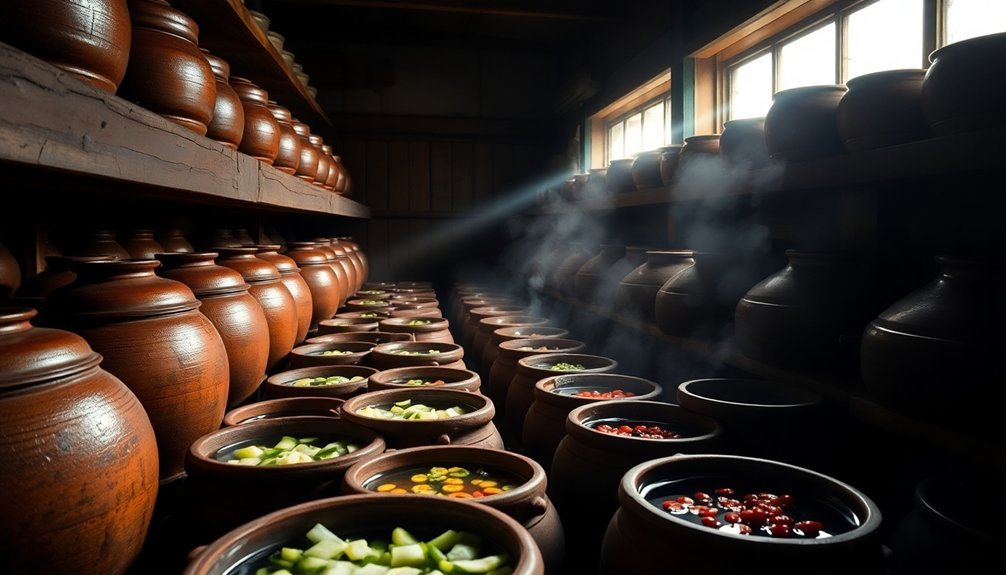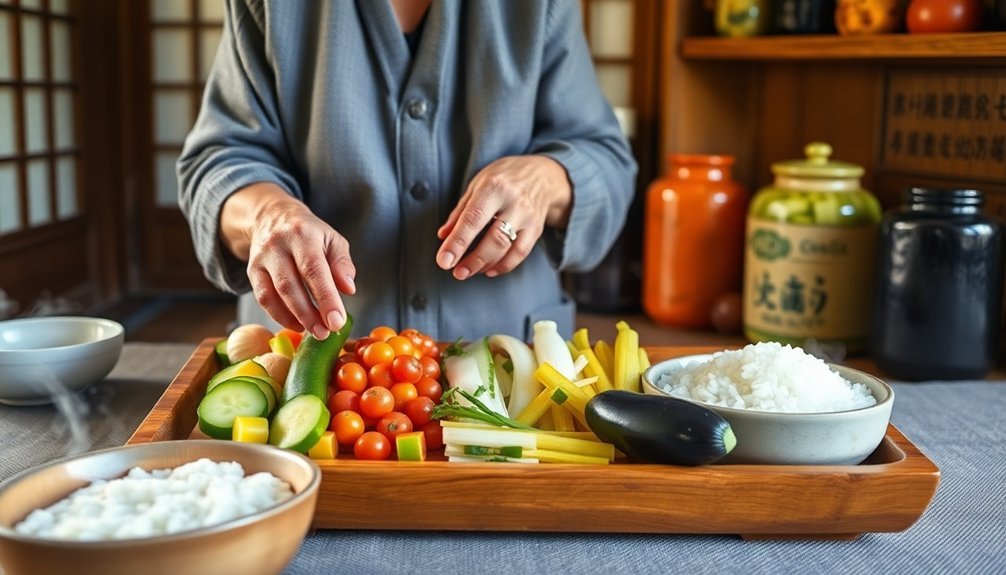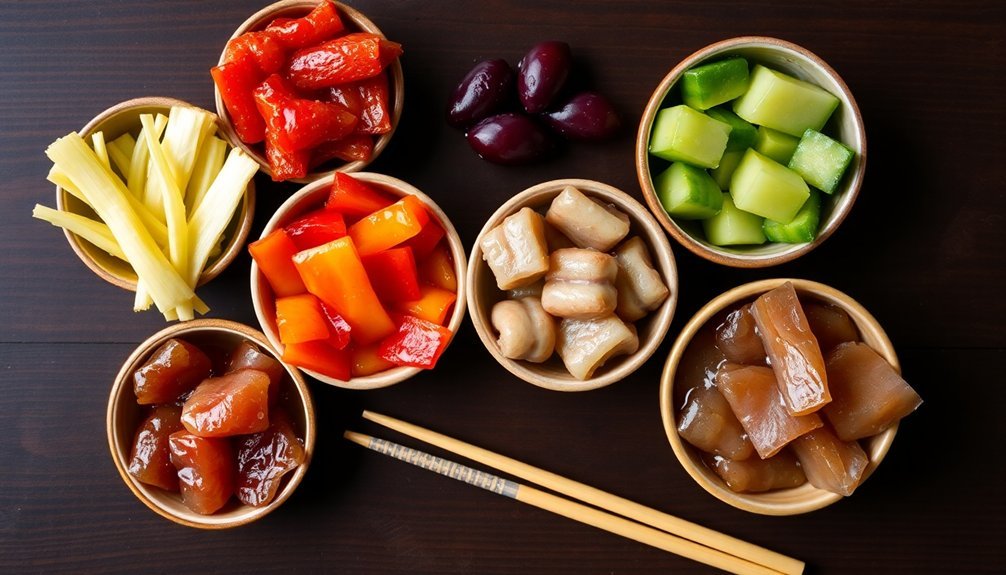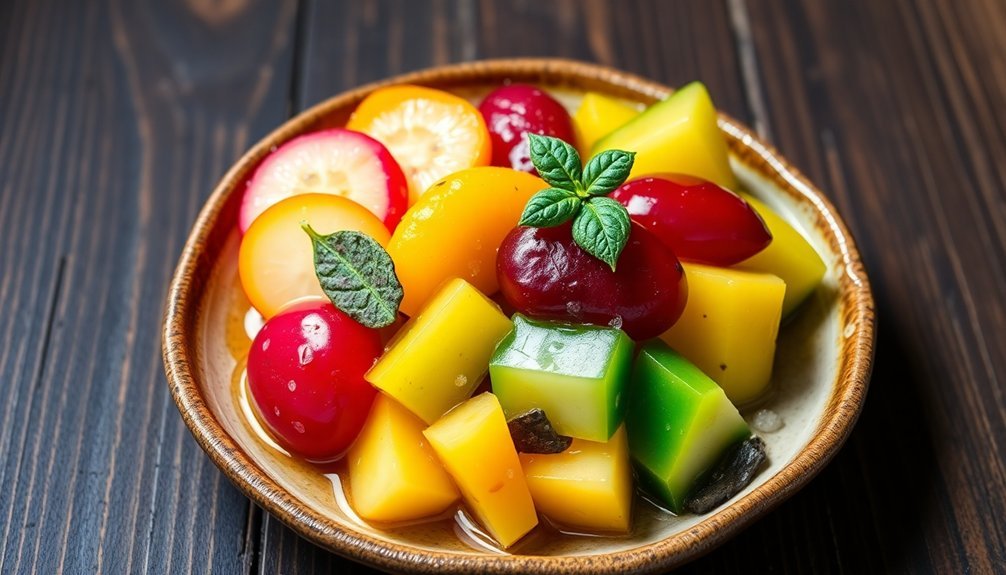Japanese tsukemono pickles get their exceptional flavor from three main elements that you'll find in every batch. First, precise salt ratios draw out moisture while preserving crunch, creating the perfect texture. Second, controlled fermentation processes develop complex flavors through bacteria like Lactobacillus, which produce tangy notes and depth. Third, carefully selected seasonal vegetables provide the foundation, enhanced by traditional ingredients like yuzu zest, shiso leaves, and sake lees. This meticulous approach, perfected over 1,400 years of Japanese culinary tradition, creates pickles that aren't just condiments – they're an essential part of Japan's rich food culture waiting to be explored.
Ancient Preservation Methods and Traditions

When you explore the origins of tsukemono, you'll discover a preservation method deeply rooted in Japanese history. Dating back to the 7th Century during the Yamato Chotei regime, these Japanese pickles emerged as an essential solution for food preservation before refrigeration existed. You'll find references to these pickles in historical texts from the 8th Century, highlighting their cultural importance.
Initially, tsukemono was a luxury enjoyed primarily by monks and nobility due to the high cost of salt. The preservation process evolved considerably over time, expanding beyond simple salt preservation to include various methods. By the 10th Century, you'd see the introduction of diverse seasonings like soy sauce, miso, sake lees, and sake, each adding unique flavors to the preserved vegetables. Today, tsukemono serves multiple roles as a garnish and digestive aid in traditional Japanese meals.
The preservation techniques you'll encounter include vinegar brining, shoyuzuke (soy sauce base), and kasuzuke (sake lees). One of the most distinctive methods is nukazuke, which uses a fermented rice bran bed called nukadoko.
These traditional methods require careful temperature control between 15°C to 25°C and daily maintenance to guarantee proper fermentation, resulting in the complex flavors that make tsukemono unique.
Essential Salting and Brining Techniques
When making tsukemono, you'll find that precise salt concentration ratios are essential, whether you're using dry salt or wet brining methods.
You can control the intensity of flavor and preservation by adjusting the salt percentage, typically ranging from 2% for tender vegetables to 10% for heartier ones.
The length of time you allow your vegetables to pickle directly influences their final texture, with shorter periods producing crisp results and longer periods creating softer, more developed flavors. For optimal results, you can experiment with natural sea salt instead of processed varieties to achieve authentic Japanese flavors.
Salt Concentration Ratios Matter
Properly understanding salt concentration ratios stands at the heart of successful tsukemono making. You'll find that salt concentrations in shiozuke brine typically range from 2% to 10%, with 5% being a common ratio that works well for most vegetables. If you're pickling leafy greens, you'll want to stick to a lower 2-5% concentration. For Japanese turnips, using one tablespoon kosher salt creates an ideal pickling environment.
Creating your brine is straightforward: for a 5% solution, mix 50 grams of sea salt with 1000ml of water, or double the salt for a 10% concentration. You'll need to boil the water with salt and let it cool before use. It's best to use natural sea salt rather than table salt, as it contains beneficial trace minerals.
The salt concentration you choose directly affects pickling time. You'll need at least 3 hours for a 2-5% brine, while stronger 5-10% solutions require 6 hours or more.
When preparing your vegetables, maintain a 2:1 ratio of vegetables to brine (1kg vegetables to 500ml brine), and cut them uniformly for even pickling. You can enhance flavors by adding kombu, chili flakes, or garlic to your brine.
Dry Versus Wet Methods
Salt concentration knowledge sets the foundation, but you'll need to decide between two main pickling approaches: dry salting and wet brining. With the dry method, you'll apply salt directly to prepared vegetables, drawing out moisture through osmosis. After letting them sweat for at least 10 minutes, you'll need to squeeze out excess water and pat them dry before proceeding.
The wet method involves immersing vegetables in a flavored brine solution. You'll need to guarantee complete coverage of the vegetables and allow them to soak for 30 minutes to overnight, depending on your desired outcome.
| Process Step | Dry Method | Wet Method |
|---|---|---|
| Preparation | Rinse, chop, remove seeds | Rinse, chop, remove seeds |
| Salt Application | Direct salt on vegetable flesh | Mixed in brine solution |
| Time Required | 10+ minutes | 30+ minutes to overnight |
| Flavor Enhancement | Add kombu, shichimi tōgarashi | Add vinegar, soy sauce, dashi |
Both methods can incorporate additional ingredients like sesame seeds, chili peppers, or kombu for enhanced flavor. The key difference lies in how the salt interacts with the vegetables – through direct contact or brine immersion.
Time Controls Texture Development
Through careful timing and salt concentration, you'll gain precise control over your tsukemono's final texture. When working with brine solutions ranging from 2% to 10% salt, you'll notice that higher concentrations require longer pickling times, while lower ones work faster.
You'll want to cool your brine before using it and maintain a 2:1 ratio of vegetables to liquid for ideal results.
For quick pickles that maintain maximum crunchiness, use a 2-5% salt brine and pickle for just 3 hours. If you're seeking a more developed flavor and softer texture, increase the salt concentration to 5-10% and extend the pickling time to 6 hours or more. You can even leave your tsukemono overnight in the fridge for enhanced taste.
To promote even texture development, keep your vegetables fully submerged in the brine and use weights or pickle presses for consistent results.
You'll find that seasonal vegetables may need different pickling times for best texture. Consider adding flavor enhancers like kombu or Shichimi tōgarashi during the pickling process to create more complex taste profiles while the texture develops.
Complex Fermentation Processes

Mastering the complex fermentation processes behind tsukemono requires understanding multiple methods, each producing distinct flavors and textures.
You'll encounter three primary fermentation techniques: lactic acid fermentation in shiozuke, rice bran fermentation in nukadoko, and alcoholic fermentation in kasuzuke.
In shiozuke, salt-tolerant bacteria convert sugars into lactic acid, creating that signature tangy flavor you've come to expect from Japanese pickles. The process requires careful salt concentration to protect against harmful bacteria while promoting beneficial ones.
When you're working with nukadoko, you'll need to maintain a fermented rice bran bed that's regularly mixed and monitored. The bed should emit a sour, miso-like scent when it's properly mature.
For deeper, more complex flavors, you might try kasuzuke, which uses sake lees in an alcoholic fermentation process that can last from one week to several months.
Temperature control is essential across all methods – you'll want to maintain 15°C to 25°C for best results. Remember to keep your vegetables fully submerged and weighted down to guarantee even fermentation and prevent mold growth.
Key Ingredients and Seasoning
Building on these fermentation methods, the foundation of great tsukemono lies in selecting and balancing the right ingredients.
You'll need fresh, seasonal vegetables as your base, with cucumbers, eggplants, daikon radish, and carrots being popular choices. Salt plays an essential role in drawing out moisture and enhancing flavor, while optional ingredients like kombu seaweed add depth through umami notes.
The seasoning liquids you choose will greatly impact your tsukemono's final taste. You can use traditional salt water brine, rice vinegar for quick pickling, or soy sauce for a richer flavor profile.
For added complexity, you'll often find these flavor enhancers:
- Aromatic additions like yuzu zest and shiso leaves
- Textural elements such as toasted sesame seeds
- Heat variations through chili peppers or Sichuan peppercorns
Your preparation technique matters just as much as your ingredients.
You'll want to massage vegetables thoroughly with salt, use proper weight pressing for even distribution, and remove air from containers to prevent spoilage.
Remember to taste your pickles at different intervals, allowing you to adjust seasonings to your preferred intensity.
Traditional Vegetables in Tsukemono

Selected for their distinct textures and flavors, traditional Japanese vegetables form the heart of tsukemono making. You'll find cucumbers and daikon radish among the most commonly used vegetables, prized for their ability to maintain crispness when pickled. These staples are often accompanied by carrots, napa cabbage, and small eggplants, each contributing unique characteristics to the final pickle.
Root vegetables play a vital role in tsukemono preparation. You can pickle young burdock root before it becomes too woody, while turnips and watermelon radish offer invigorating crunch. Don't overlook ginger, which adds a zesty kick to various pickle combinations.
For leafy options, you'll discover both standard and napa cabbage frequently used in quick pickles. Mustard greens and scallions bring sharp, peppery notes, while shiso leaves contribute their distinctive herbal flavor.
You can even experiment with less common ingredients like kabocha pumpkin and water lily root for unique variations.
The versatility of Japanese pickling extends to fruits as well, with ume plums occasionally making an appearance in traditional tsukemono preparations, adding a tart and salty dimension to the pickle spectrum.
Unique Japanese Flavor Combinations
Japan's distinctive flavor combinations elevate tsukemono beyond simple pickled vegetables. You'll find that each pickling style creates unique taste profiles, from the salty depth of shoyuzuke to the sweet-tangy notes of amazuzuke. These traditional methods often incorporate complementary seasonings that enhance the overall flavor experience.
The complexity of Japanese pickling comes from masterful flavor pairings that you'll discover in various preparations:
- Miso and black garlic create an intense umami foundation that transforms ordinary vegetables into deeply savory treats.
- Yuzu kosho adds bright citrus notes and spicy heat, particularly effective when combined with traditional pickling methods.
- Ponzu and dashi work together to deliver a perfect balance of tangy, savory, and umami flavors.
You'll notice how sake lees (kasuzuke) contribute subtle alcoholic notes, while the combination of yuzu and miso brings together citrusy brightness with fermented depth.
Modern tsukemono often incorporates these traditional pairings in innovative ways, such as combining bonito flakes with pickled tofu or adding yuzu kosho to conventional pickle bases. These thoughtful combinations guarantee that each bite delivers a complex, multilayered taste experience.
Cultural Impact Through Generations

While distinctive flavor combinations highlight tsukemono's culinary artistry, their cultural significance runs far deeper in Japanese society. You'll find these traditional pickles have been an integral part of Japanese cuisine for nearly a millennium, evolving from simple salt preservation methods during the Heian Period to the complex, flavorful preparations you see today.
When you sit down for a traditional Japanese meal, you'll notice tsukemono's vital role in creating harmony and balance. They're not just condiments; they're important elements that cleanse your palate and aid digestion while adding vibrant colors to your dining experience.
You'll encounter these pickles at everything from casual family meals to formal tea ceremonies and festivals.
As you travel through Japan, you'll discover how each region has developed its own unique tsukemono varieties. Whether it's Kyoto's sweet vinegar Asazuke or Nara's thousand-year-old Kasuzuke tradition, these regional differences showcase Japan's diverse culinary heritage.
In modern times, tsukemono continue to bridge generations, maintaining their significance from their early preservation roots to today's commercial production, while still preserving their essential role in Japanese dining culture.
Health Benefits of Fermented Pickles
When you eat fermented Japanese pickles, you're getting a powerful dose of beneficial probiotics that support your digestive system and overall gut health.
These living microorganisms help your body break down food more efficiently while strengthening your immune system's natural defenses.
The probiotics in tsukemono can actually outnumber those found in supplements, making these traditional pickles an excellent choice for maintaining your digestive wellness.
Probiotic Power For Digestion
Traditional tsukemono delivers more than just tangy flavors – it's a powerhouse of probiotic benefits for your digestive system. These fermented Japanese pickles are packed with beneficial bacteria like Lactobacillus that can survive your stomach acid and reach your intestines, where they're most effective.
When you consume tsukemono regularly, you're introducing helpful microorganisms that support your gut's natural balance and help fight off harmful bacteria.
The fermentation process makes these pickles particularly valuable for your digestive health in three key ways:
- The beneficial bacteria partially break down the vegetables, making nutrients more accessible and easier for your body to absorb.
- The process creates natural prebiotics that feed your existing gut bacteria, promoting a healthier microbiome.
- The fermentation enhances vitamin content, especially B-vitamins, while preserving the vegetables' original nutrients.
You'll find that tsukemono can help ease common digestive issues like bloating and constipation while supporting your body's nutrient absorption.
The combination of probiotics, enhanced nutrients, and preserved minerals makes these pickles an excellent addition to your daily diet for maintaining ideal digestive health.
Immune-Boosting Microbial Benefits
The immune-boosting potential of tsukemono extends far beyond basic nutrition. When you consume these fermented Japanese pickles, you're introducing beneficial bacteria like Lactobacillus and Bifidobacterium that survive stomach acid and reach your intestines, where they're most effective.
These microbes help maintain a diverse, healthy gut microbiome that reduces chronic inflammation and disease risk.
You'll benefit from tsukemono's rich antioxidant content, including flavonoids and phenols that protect your cells from oxidative stress. The fermentation process enhances these compounds' bioavailability, while also producing alkyl catechols that activate your body's defense pathways against chronic diseases, including cancer and neurodegeneration.
The probiotic strains in tsukemono, particularly L. brevis, stimulate interferon production, which activates natural killer cells to defend against infections.
You're also supporting your digestive health, as these beneficial bacteria aid in nutrient absorption and vitamin synthesis. Research suggests that regular consumption of fermented foods like tsukemono may reduce your risk of colorectal cancer, Parkinson's disease, and even help manage anxiety and depression through the gut-brain connection.
Serving With Japanese Cuisine

Serving tsukemono alongside Japanese cuisine isn't just about tradition – it's an integral component that brings harmony to every meal. You'll find these Japanese pickles perfectly integrated into the ichiju-sansai structure, where they provide vital contrasts in both flavor and texture. As you enjoy your meal, they'll cleanse your palate between bites and add vibrant visual appeal to your dining experience.
These versatile pickles enhance your meal in several key ways:
- They balance rich dishes with tart and invigorating flavors, especially when you're enjoying su-zuke or amazuzuke varieties.
- They complement alcoholic beverages at izakayas, making them perfect companions for sake or beer.
- They add depth to traditional ceremonies, from formal tea services to family gatherings.
Whether you're dining at a restaurant or preparing a meal at home, you'll appreciate how tsukemono can be served hot or cold, working as both garnishes and side dishes.
Their diverse textures and flavors, ranging from crunchy to tender and salty to sweet, make them incredibly adaptable to various dining situations. You'll find them especially valuable when pairing with main courses, where they contribute an extra dimension of umami to your meal.
Regional Tsukemono Variations
Throughout Japan, tsukemono variations reflect distinct regional identities shaped by local ingredients, climate conditions, and cultural traditions. You'll find unique specialties across different prefectures, from Kyoto's sweet and sour senmaizuke to Hokkaido's seafood-rich matsumaezuke.
Climate and local availability greatly influence pickling methods and ingredients. In regions with harsh winters, you'll discover preservation techniques designed for longer storage, while coastal areas incorporate local seafood into their pickling traditions.
| Region | Signature Pickle | Key Characteristics |
|---|---|---|
| Kyoto | Senmaizuke | Sweet-sour, crunchy turnip pickles |
| Nara | Kasuzuke | Sake lees-based, rich umami flavor |
| Hokkaido | Matsumaezuke | Seafood-based with squid and herring roe |
| Wakayama | Umeboshi | Sour-salty plums with red shiso |
These regional variations showcase Japan's diverse pickling heritage, with each area developing its signature methods based on local resources. For instance, Nara's kasuzuke emerged from the region's sake brewing tradition, while Hokkaido's matsumaezuke reflects its rich marine resources. You'll notice how different areas adapt basic pickling methods like shiozuke and nukazuke to create distinctive local flavors using seasonal vegetables and regional seasonings.
Frequently Asked Questions
Can You Freeze Tsukemono to Extend Its Shelf Life?
You shouldn't freeze tsukemono as it'll ruin their crisp texture and make them mushy. Instead, store your Japanese pickles in an airtight container in the refrigerator, where they'll stay fresh for months.
Why Do Some Tsukemono Turn Bright Yellow or Purple?
You'll see tsukemono turn yellow due to bacillus subtilis bacteria during fermentation, while purple colors come from red shiso leaves or umezu (plum vinegar). Both processes naturally transform these Japanese pickles' appearance.
What's the Best Container Material for Making Tsukemono at Home?
You'll get the best results using glass containers, as they're non-reactive and won't affect flavors. While plastic's convenient, glass is easier to clean, doesn't retain odors, and won't leach chemicals into your pickles.
How Long Can Opened Tsukemono Last in the Refrigerator?
Your opened tsukemono will last 3-4 days for asazuke (quick pickles) and up to several months for traditional pickles like nukazuke. Keep them in an airtight container and check regularly for freshness.
Can Pregnant Women Safely Eat Fermented Tsukemono?
While you can eat tsukemono during pregnancy, it's best to be cautious with fermented varieties. Consult your healthcare provider first, and choose commercially-prepared options over homemade ones to minimize listeria risks.
In Summary
You'll find tsukemono's incredible flavors come from centuries of perfected preservation techniques, masterful fermentation, and carefully selected ingredients. Whether you're enjoying crisp nukazuke or tangy umeboshi, you're tasting Japan's culinary heritage in every bite. As you explore these traditional pickles, you're not just experiencing bold flavors – you're connecting with a time-honored art that continues to enhance Japanese meals and preserve cultural identity.





Leave a Reply